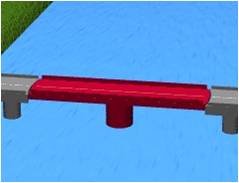CLASSIFICATION OF BRIDGES (Part-2)
Classification of Bridges
• Bridge can be classified in different ways depending upon:-
• High Flood Level
• Position of bridge floor
• Inter-Span Relation
• Nature of superstructure action
• Alignment of the Superstructure w.r.t obstacle
• Material
• Span length
• Type of connection
According to Alignment of the Superstructure relative to the Obstacle
- Right Bridges:– These are bridges at right angles to the axis of the river.
- Skew Bridges:- These are bridges that are not at right angles to the axis of the bridge.
- Underbridges:- It is a bridge constructed to enable road to pass under another work or obstruction.
- Overbridges:- It is a bridge to enable one form of land communication over the other
According to Material of Construction
• Timber
• Masonry
• Steel
• RC
• Pre-stressed
• Composite
According to Purpose of Use/Function
• Aqueduct (A bridge that is constructed to convey water over an obstacle,
such as a ravine or valley)
• Viaduct (Bridge composed of several small spans of road/railway for crossing a valley or a gorge. It is derived from the Latin viafor road and ducereto lead something. Many early viaducts comprised a series of arches of roughly equal length.
• Highway
• Railway
According to method of clearance for navigation
Navigable Channels where permanent or clear waterway cannot be provided, movable bridges are provided.
Swing Bridge
A swing bridge has balanced girders swinging round a quadrant of a circle or horizontally over a pier or a pivot.
• It is used for road traffic and when desired to permit for navigation , the bridge rotates thro’ an angle of 90 degree

Bascule/Draw Bridge
• Bridge whose deck is composed of two spans joining each other at the middle of the bridge and pivoting around a vertical axle at each abutment.
• Can be lifted up at will to allow for boat or streamer traffic under it.
• Can be readily raised or lowered by rack and pinion arrangement as they are counterweighted at the ends.
• As the bridge opens , the counterweights lower into a pit called Bascule Chamber
Lift bridge
• A vertical-lift bridge or just lift bridge is a type of movable bridge in which a span rises vertically while remaining parallel with the deck.
• The vertical lift offers several benefits over other movable bridges
• They cost less to build for longer moveable spans
• Although most vertical-lift bridges use towers, each equipped with counterweights, some use hydraulic jacks located below the deck.

According to Span Length
• Culverts with spans less than 8m
• Minor Bridges with spans between 8-30m
• Major Bridges with spans above 30m
• Long Span Bridges with spans above 120 m: Suspension and Cable Stayed Bridges
Span Range type of Bridge
• 4m-7m Reinforced Concrete (RC) Slab Culvert
• 7m-15m Prestressed Concrete (PSC) Slab Bridge
• 15-25 m RC/PSC T-Beam and Slab Bridge
• 25m-60m PSC Beam and Slab/Steel plate girder
• 50-100m Balanced Cantilever Bridge(RC/PSC)
• 75m-150m PSC box girders using cantilevered construction /Steel Truss
• 150m-500m Cable Stayed with RC/PSC decks
• 500m-1800m Suspension/Cable Stayed with steel decks
According to Type of Connection
• Riveted
• Welded
• Pin- connected
Economical Span Ranges & Configurations for Bridge Decks
• Materials like timber and steel have been replaced by new materials
• High Strength and High Performance
• Concrete
• Reinforced and Pre-stressed Concrete
• High Tensile steel wires, bars, strands, cables and polymeric materials.
Modern Trends in Bridges Engineering
• New Types of Pre-stressed Concrete and Cable Stayed Bridges
• Long Span Cable Stayed Bridges with Hybrid Decks using steel girders, concrete slabs, high tensile steel cables
• Cantilever method of construction is the latest and most popular method generally adopted for construction of long span pre-cast or cast in–situ Prestressed segmental bridges
• PSC cellular box girder bridges for urban flyovers

